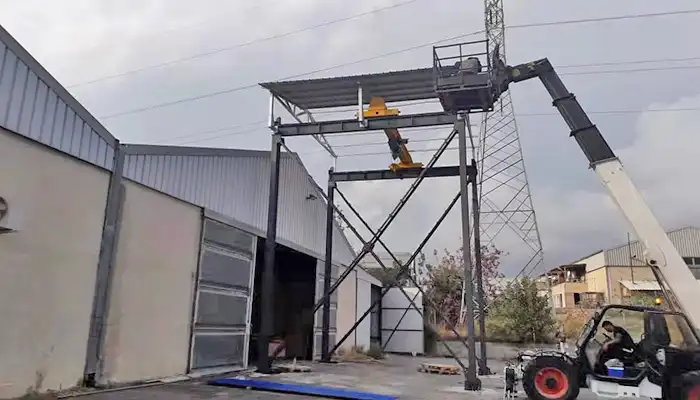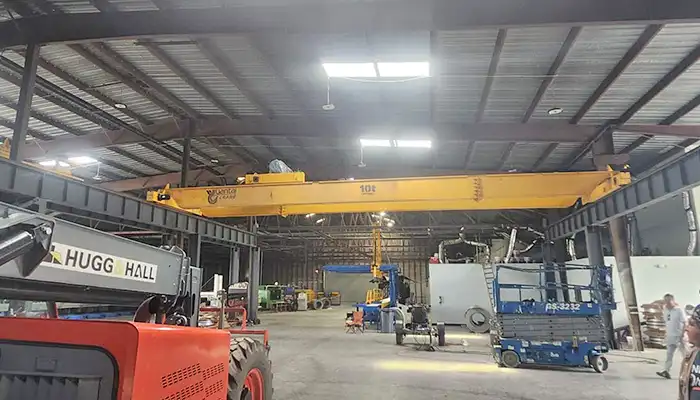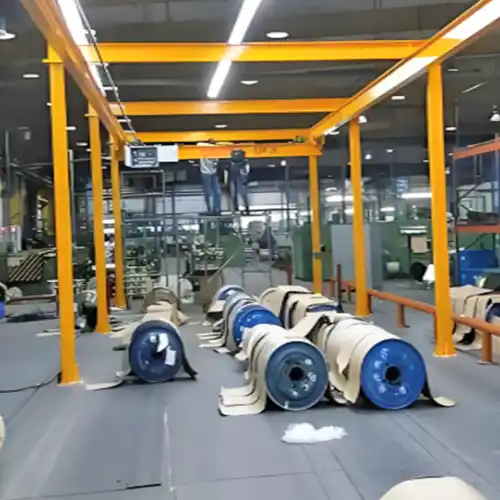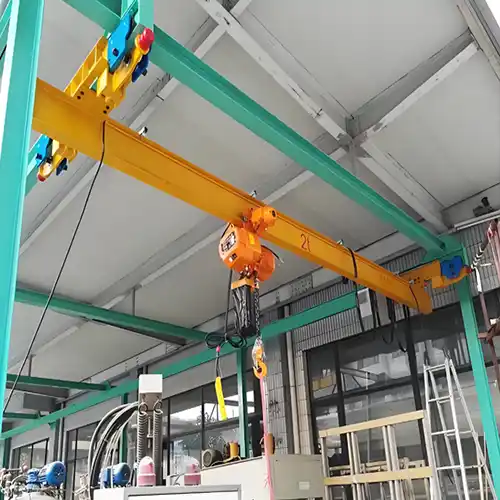Free Standing Bridge Cranes for Sale | Design, Setup & Price
Explore cost-effective free standing bridge crane systems with custom design, smooth installation, and expert guidance for industrial lifting needs.
Category: Freestanding Bridge Crane
Your Trusted Freestanding Bridge Crane Manufacturer & Supplier
Free Standing Bridge Cranes for Sale
Freestanding Bridge Crane System Design, Installation & Price
A free standing bridge crane is a type of overhead crane that supports itself. It doesn't rely on your building’s structure—instead, it stands on its own steel columns and beams. This makes it a great option for workshops or factories where the building can’t support a crane, or where structural changes are too expensive.
So, why choose a free standing crane instead of a building-supported one?
- You don’t need to modify your building.
- It’s easy to install in older or lightweight structures.
- You can move or expand the system later if needed.
These cranes are commonly used in:
- Manufacturing plants
- Warehouses
- Maintenance and repair shops
- Small- to mid-sized workshops
They’re ideal for places that need safe and efficient overhead lifting, but can’t or don’t want to install a crane on the building structure.
In this guide, we’ll explain how these cranes work, how to design the right system, and what to know about installation and pricing—so you can choose the right freestanding bridge crane for your needs.

Free Standing Bridge Crane System Design Overview
A free standing bridge crane system is built from several core components, all working together to provide safe, efficient overhead lifting—without relying on your building for support.
Key Components of a Free Standing Crane System
- Runway columns – Vertical support structures that are anchored to the floor. They form the main support framework of the crane system.
- Runway beams – Horizontal beams mounted on the columns that guide the bridge's travel along the system length.
- Bridge girder – The beam that spans between the runway beams and carries the trolley and hoist.
- Hoist and trolley – The hoist does the lifting, while the trolley allows it to move across the bridge.
Design Variations to Match Your Lifting Needs
- Single girder cranes – More compact and cost-effective. Ideal for light to medium loads (like 1 to 10 tons).
- Double girder cranes – Provide more lifting height and handle heavier loads (10 tons and above). Suitable for longer spans or higher frequency use.
Modular Design and Customization
One of the great things about free standing crane design is how modular it is. That means:
- Easy to expand or reconfigure as your workflow changes
- Compatible with different hoist types (electric chain, wire rope, manual)
- Options for custom span lengths, lifting height, and column spacing
- Can be fitted with accessories like festoon systems, limit switches, or remote controls
Fits Around Your Facility, Not the Other Way Around
Unlike building-supported cranes, free standing systems are flexible. You don’t have to redesign your space—they’re designed to fit your space. Whether your workshop is narrow, has low ceilings, or needs to avoid certain equipment or paths, the system layout can be tailored to:
- Your available floor space
- Obstructions or clearance limits
- Material flow or workstations
- Load types and lifting paths
With a solid free standing bridge crane system, you're not locked into one setup—it adapts with your operations.
Technical Specifications
Understanding the freestanding bridge crane specifications is key to choosing the right system for your workspace. From load capacity to control methods, each technical aspect affects how well the crane performs in your specific application.
Load Capacities and Span Ranges
Freestanding bridge cranes are commonly available in capacities ranging from 1 ton to 10 tons, though systems can be engineered for up to 20 tons or more for special use cases.
- 1–3 ton systems are often used in assembly lines, maintenance shops, and warehouses.
- 5–10 ton systems serve heavier manufacturing environments like fabrication shops, steel parts handling, or machinery workshops.
- Span lengths typically range from 4 meters to 20 meters, depending on your layout and support column spacing.
Tip: A longer span requires more robust structural components. Always confirm building clearance and available floor area when specifying span length.
Lifting Heights and Headroom Requirements
The lifting height (distance from the floor to the hook when fully raised) is a crucial part of crane design. You can specify:
- Standard lifting heights: 3 to 6 meters for indoor light-duty use.
- Custom lifting heights: Up to 10 meters or more for high-bay workshops or outdoor applications.
Headroom (space above the hook to the top of the crane) also matters in tight facilities. Low-headroom hoists are available to maximize lift even when ceiling height is limited.
- Use low-headroom electric hoists in low-clearance workshops
- Plan for at least 500–700 mm of clearance above the crane girder for safe operation and maintenance access
Hoist Compatibility – Match the Hoist to the Job
Your crane's performance is only as good as the hoist it uses. Freestanding bridge cranes can be paired with different types of hoists depending on load and usage:
- Electric wire rope hoists – Best for higher capacities (5 tons and above), longer duty cycles, and faster lifting speeds
- Electric chain hoists – Compact, lower cost, easier to maintain; ideal for 1–3 ton light-duty use
- Manual chain hoists – For occasional lifts or budget-limited operations with lower capacity needs
Make sure your hoist includes overload protection, thermal protection, and appropriate lifting speed.
Control Options – How You Operate the Crane
Freestanding bridge cranes come with several control system options to suit your workflow and safety requirements:
- Pendant control – Simple and reliable, attached to the hoist or trolley
- Wireless remote control – Flexible, safe, allows the operator to move freely and stay out of the load path
- Cabin control – Rare for low-capacity systems, but available for special cases involving high lifts or hazardous loads
For most 1–10 ton systems, pendant or remote control is standard. Some cranes offer dual-mode control (pendant + remote) for added flexibility.
Installation Process
Installing a free standing bridge crane requires careful planning to ensure safety, stability, and performance.
Site Preparation
- Foundation strength: A reinforced concrete floor is essential to support the columns and crane structure.
- Minimum floor thickness: Typically 200–300 mm, depending on crane capacity and column base size.
- Check for obstructions: Ensure the crane path is clear of HVAC, lighting, or piping systems.
Delivery Options
- Turnkey installation: Crane supplier handles design, delivery, installation, and testing—best for users without technical resources.
- Crane kits: Delivered as modular components for local assembly—ideal for buyers with fabrication experience or local support.
Installation Steps & Timeline
- Layout marking & anchor preparation
- Column erection & runway alignment
- Bridge girder and hoist installation
- Electrical wiring and control setup
- System alignment and function check
Typical timeline: 5–10 working days for a standard 5-ton system, depending on site conditions.
Safety Checks Before Commissioning
- Mechanical inspection of structure and joints
- Electrical testing of hoist, limit switches, and controls
- Load testing at 100–125% of rated capacity to ensure safe operation
- Final sign-off by a certified inspector or your crane supplier
Pricing Guide
Keywords: free standing bridge crane price, free standing crane for sale cost
Understanding the cost structure of a freestanding bridge crane helps you plan and budget effectively.
Key Factors Affecting Price
- Lifting capacity: Heavier capacities require stronger structures (e.g., 10-ton vs. 5-ton).
- Span length and lifting height: Longer spans and higher lifts need more material and custom engineering.
- Design type: Single girder is more economical; double girder adds cost but improves hook height and stability.
- Features: Options like radio remote control, anti-sway, and inverter control add to the price.
Price Comparison: Free Standing vs. Building-Supported Cranes
| Crane Type | Structural Cost | Building Mod Required | Flexibility | Common Use Case |
|---|---|---|---|---|
| Free Standing | Higher | None | High | New builds, rental spaces |
| Building-Supported | Lower | Yes (supports needed) | Limited | Permanent installations |
Additional Costs to Consider
- Foundation work: $2,000–$10,000 depending on soil and size
- Installation & commissioning: Typically 10–15% of crane cost
- Routine maintenance: Annual cost varies by usage, but plan ~3–5% of crane cost per year
Typical Price Ranges
| Capacity | Approximate Price Range (USD) |
|---|---|
| 5 ton | $18,000 – $25,000 |
| 10 ton | $25,000 – $38,000 |
| 15 ton | $35,000 – $45,000 |
| 20 ton | $45,000 – $60,000 |
Prices vary depending on customization, span, control type, and country-specific installation services.
Advantages of Free Standing Bridge Cranes
Free standing bridge cranes offer clear benefits, especially for facilities where building structure support isn't practical or even possible. These systems stand on their own steel columns and don’t rely on your building’s roof or walls for support.
Here’s why many workshops and factories prefer them:
- Independent from Building Structure
Perfect for leased spaces or older buildings with weak ceilings or low load-bearing capacity. - Easier to Relocate or Expand Later
Planning to move or expand in the future? A freestanding bridge crane can often be dismantled and reinstalled elsewhere. - Ideal for Temporary Setups
In cases where operations might move within a few years, free standing cranes are far more flexible than fixed alternatives. - Space-Saving in Tight Layouts
Column positions can be customized to avoid interfering with your workflow or machinery.
If your facility changes often, or you're renting your space, these freestanding systems could be the right long-term investment.
How to Choose the Right Free Standing Bridge Crane
Picking the right crane starts with knowing your space and your lifting needs. There’s no one-size-fits-all solution—especially for freestanding systems, which are typically tailored to fit.
Here’s what to consider when choosing:
- Understand Your Facility Conditions
Look at ceiling height, floor strength, available space, and any potential obstructions. - Match Capacity and Span to Your Loads
Know your maximum load weight, how often you'll lift it, and the working area the crane should cover. - Think About Control and Safety
Do you need simple push-button control or wireless remote control? Is load visibility critical? - Keep Installation and Budget in Mind
Don’t just look at crane cost—foundation work, shipping, and local installation all add up. - Consult with Crane Suppliers or Engineers
A quick talk with an expert can help avoid over- or under-designing the system.
Remember, choosing a freestanding bridge crane is about balancing what your facility needs now and how it might evolve in the next 5 to 10 years.
Frequently Asked Questions (FAQ)
What are the floor requirements for a free standing bridge crane?
A reinforced concrete floor is typically required. The thickness usually ranges from 6 to 12 inches, depending on the crane’s capacity and the column base design. Specific requirements are provided in the technical documentation.
Can a freestanding crane be relocated?
Yes. Freestanding bridge cranes are designed for flexibility and can be dismantled and moved to a new location, making them ideal for leased facilities or evolving production lines.
What kind of maintenance is needed?
Regular maintenance includes inspecting the hoist, checking fasteners and anchor bolts, lubricating moving parts, and verifying electrical controls. Most systems are built for easy servicing and long-term reliability.
How long does installation take?
Installation time varies by crane size and site conditions. A typical 5-ton freestanding bridge crane may take 3 to 5 days to install, including alignment, anchoring, and testing. Larger or more complex systems may require more time.
Send Us An Inquiry
If you're looking for a free standing bridge crane for sale, we’re here to provide expert guidance and fast support.
To get started, send us your facility layout and lifting requirements. We'll prepare a customized solution with:
- Technical drawings and crane specifications
- A detailed quotation based on your application
- Optional support for installation and maintenance
For a personalized consultation and accurate quote on freestanding cranes , contact our team today.
Related Products

Affordable 10 ton double girder overhead crane with CD/MD hoist trolley, built for U.S. standards, ideal for construction and industrial lifting
Free consultation to Confirm Parameters & Specifications and Get
Latest Crane Price & Crane Rate.
- Types of overhead cranes : _______?
- Optional: Overhead travelling crane, goliath gantry crane,Slewing jib crane, Single girder or double girder crane,small portable crane or kbk crane, etc.
- Capacity of overhead crane: _______?
- Optional: 0.25ton, 0.5 ton, 1 ton, 2 ton, 3ton, 5 ton, 10 ton,15ton, 20ton, 25 ton, 30ton,35ton, up to 550ton, etc.
- Crane span & lifting height : _______?
- Crane travelling length : _____?
- Control of overhead crane:_______?
- Optional: pendant/ remote/cabin control
- Voltage supply of overhead crane:_____?
- Eg,: 380V50/60HZ,3Phase or others,etc.
- Application/usage of crane:_______?
- Eg,: Steel mill, ,injection mold, cement,stone, concrete,granite, general manufacturing, etc.
Just leave a message via the contact form and our hoist and crane engineer will contact you with in 24working hours.
Get In Touch

